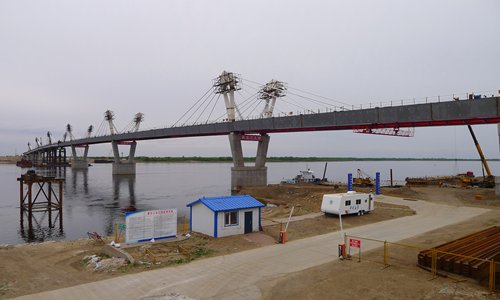
A cross-border China-Russia railroad bridge is under construction on Sunday in Northeast China's Heilongjiang Province. The bridge will link Heihe in Heilongjiang Province with the Russian Far East city of Blagoveshchensk across the Heilongjiang (Amur) River. The construction of the bridge started in 2016, and it is scheduled to start carrying traffic this October. The whole route covers 19.9 kilometers, with 6.5 kilometers in China and 13.4 kilometers in Russia, media reports said. Photo: VCG
Russia is engaged in the upgrade of its Trans-Siberian railway and other Far East rail network infrastructure, a strategic move that Voice of America(VOA) said in a Monday report Russia has taken to strengthen ties with China against the background of the latter's souring relations with the US and Australia.
The regional economic impact and significance of an improved Far East railway network will be enormous. Thus, a reading of the reported plan to remodel Russia's rail network simply from a political perspective seems far-fetched and misleading.
For starters, increased transportation capacity as a result of upgraded Far East railway infrastructure will directly promote the economic and trade cooperation between China and Russia. Ever since the deterioration of the China-Australia relationship, Russia has been widely seen as a potential supplier replacing Australia when it comes to exporting resource products to China. But the shortage of rail transportation capacity makes it hard for this potential to be fully released.
If the reported upgrade of Far East rail infrastructure could help Russia export more coal and agricultural products to China, the Russian economy will certainly receive a boost and China will also see a remarkable progress in its supply-chain diversification push.
Moreover, from the broader level of Eurasia connectivity, Russia's improved rail network construction will also have positive impact on the neighboring economies, conducive to enhancing the appeal and competitiveness of railway transportation across the Eurasian.
With the COVID-19 pandemic causing a sharp decline in air cargo capacity, soaring shipping rates and port congestion, many have turned their attention to rail freight transportation between Asia and Europe. It is against such a background that the New Eurasian Land Bridge, an important infrastructure program promoted by the Belt and Road Initiative (BRI), has been playing a growing role in connecting Asia and Europe. In this sense, Russia's rail infrastructure network has also become increasingly important in terms of the Eurasian connectivity.
Russia's reported upgrade of the Far East rail network is welcomed and China also has the willingness to further unleash the market potential of the Eurasian freight routes under the BRI framework. Given the strategic significance of the Eurasian railway network to the regional economies, China and many countries along the routes have been trying their best to improve the transportation capacity of the New Eurasian Land Bridge so as to make these railways truly the economic arteries traversing the Eurasian continent.
For years, China has offered help to the China Europe freight trains to support the normal operation of the railway lines, and this input has paid off with the cross-border train gradually becoming a pillar for trade along the routes. In the first six months of this year, 7,323 freight trains ran between China and Europe, up 43 percent year-on-year. The number of single-month freight train runs exceeded 1,300 in June, setting a streak of more than 1,000 freight train runs for the past 14 consecutive months, according to China's National Reform and Development Commission.
In this sense, Russia's railway upgrade will likely promote its own economic development, facilitate China's diversification strategy, and boost the Eurasian trade. It is such real market needs that are driving regional infrastructure construction, not politics.




